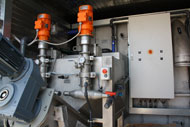Wastewater Treatment Plant Features
Remote Monitoring and Operations

Remote monitoring and operating ensures optimal results for regulatory compliance and reduces unnecessary service costs.
With access to internet either cell phone service or satellite service our operators can remotely monitor and operate all aspects of the waste water treatment plant. A schematic of the plant allows for visualization of capacity, fill volumes, flow rates, valve position and operational status equipment such as blowers and pumps.
Furthermore our trained Operators can control operations of the plants remotely and complete functions such as starting and stopping pumps, clearing errors and starting/stopping entire processes. Our plants have alarms for low and high tank levels, equipment errors, low temperatures and our operators receive instant notification if any pre-set parameters deviate from expected. The Programmable Logic Controller or PLC also records data and provides real time and historical trends which our Process Engineers can review and optimize plant performance.
Sludge Dewatering

All sludge produced in the treatment plant is dewatered and pressed to a high dry solids content of approx. 15 % or even higher (depending on the sludge origin) without using any chemicals. A buffer tank collects the dried sludge, which is then extracted by an auger. This solution requires low maintenance efforts because the collected sludge cake can be stored for a comparatively long period of time in a sludge bin within the container and disposed of easily.
Low Energy Consumption
Though the selection of energy efficient equipment with low power consumption our packaged systems have significantly smaller power requirements than conventional systems.
| Plant Size | Energy Consumption |
|---|---|
| 5 m3/day Multi-pack | 14 Kw's |
| 12.5 m3/Day(35 Persons) | 16 Kw's |
| 25 m3/Day(60 Persons) | 18 Kw's |
| 60 m3/Day(150 Persons) | 22 Kw's |
| 120 m3/Day(600 Persons) | 37 Kw's |
Membrane Bioreactor (MBR)
Wastewater enters the anoxic zone of the plant where it mixes with the return sludge. There a de-nitrification process using Bio-Media takes place. Bacteria stick on the free floating Bio-Media and accumulate. The wastewater then passes the aeration zone where the bacteria grow and consume organics that are in the wastewater. The final treatment within the MBR is done by a subsequent membrane filtration.
This process also eliminate suspended solids as well as micro organisms resulting in a high level of effluent quality Due to the highly efficient Bio-Media and the absence of secondary settlement tanks, the MBR is extremely compact and space saving.